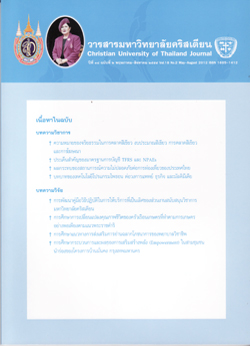ความหมายของจริยธรรมในการตลาดสีเขียว งบประมาณสีเขียว การตลาดสีเขียวและการโฆษณา
บทคัดย่อ
ทุกวันนี้ผู้บริโภคตระหนักเกี่ยวกับการที่ผู้ประกอบกิจการจะติดป้ายผลิตภัณฑ์ว่าเป็นสีเขียวหรือเป็นมิตรกับสิ่งแวดล้อม เพื่อวัตถุประสงค์ที่จะได้รับการยอมรับว่าสีเขียว หมายถึง การรักษาสิ่งแวดล้อม ซึ่งจะเป็นประโยชน์ที่คิดว่าธุรกิจเปรียบเสมือนมนุษย์ผู้มีชีวิต อย่างไรก็ตามความไม่คล่องตัวทางการเงิน การเมือง และสถาบันสังคม ที่จะผสมผสานระบบสวัสดิการสังคม เศรษฐกิจ และนิเวศน์วิทยาเข้าด้วยกันอันนำไปสู่ความไม่สามารถในการพัฒนาอย่างยั่งยืนการลดมลพิษและของเสียผ่านระบบภาษีและงบประมาณ ไม่สามารถนำไปสู่การตัดสินใจด้านงบประมาณ ยิ่งไปกว่านั้นผู้บริโภคสีเขียวหรือผู้เป็นมิตรกับสิ่งแวดล้อมได้ตระหนักว่าเขามีชีวิตอยู่ในระยะวิกฤติทางสิ่งแวดล้อม เขาได้รับการสนับสนุนให้มีการดำเนินการตอบโต้กับปัญหาเหล่านี้ จึงเห็นได้ว่าการติดป้ายฉลากสีเขียวและผลิตภัณฑ์สีเขียวได้แสดงถึงการร่วมกันในการพิทักษ์สิ่งแวดล้อม
เอกสารอ้างอิง
Adams, W M. (1990). Green development : Environment and sustainability in the third world London : Routledge.
Alex Black. (2007). “Telling the story of going green”. PR week (London ed.).London : (Jun 8) : 22.
Anonymous. B to B. (2007). “Make a (Proof) point when going green.” Administrative Science Quarterly. 92(17 Dec 10) : 34.
Anonymous. (2008). “Green businesses : From risk management to opportunity capitalization”. PR News. 64 (31 Potomac : Aug 11).
Anonymous. (2008). “Tip sheet : Communicating green activity responsibly”. PR News. 64(19, Potomac : May 12).
Anonymous. (2008). “Consumers put ads to greenwashing test ; Public invited to submit advertising”. PR Newswire. samples at Greenwashinglndex.com New York : (Jan 7).
Anonymous. (1997). “Environmental audit certification”. CMA. 71(7 Sep) : 35.
Baines, Paul, Egan, John, Jefkins, Frank William. (2003). Public relations : Contemporary issues and techniques. Amsterdam : Elsevier/Butterworth-Heineman.
Banerjee, Subhabrate, Gulas, Charles S, Iyer, Easwar. (1995). “Shades of green : A multidimensional analysis of environmental advertising”. Journal of Advertising. 24(2 Armonk: Summer) : 21.
Bauer, Raymond A. (1973). “The corporate social Audit : Getting on the learning curve”. California Management Review. 16/1 (Fall 1973) : 5-10.
Bennett, Steven J., Freierman, Richard., George, Stephen. (1993). Corporate realities and environmental truths : Strategies for leading your business in the environmental era. New York : Wiley.
Butcher, Bernard L. (1973). “The program management approach to the corporate social audit”. California Management Review. 16(1) : 11-16.
Chrisanthi Avgerou, Claudio Ciborra, and Frank Land, eds. Gavin M Schwarz.(2005). “The social study of information and communication technology: Innovation, actors, and contexs.” Administrative Science Quarterly. 50(1) : 152.
Clare D'Souza, Mehdi Taghian. (2005). “Green advertising effects on attitude and choice of advertising themes.” Asia Pacific Journal of Marketing and Logistics. 17( 3,Patrington) : 51.
Corbett, Charles, and Luk N. Van Wassenhove, (1993). The green fee : Internalizing and operationalizing environmental issues.” California Management Review. 36(1)_ : 116-135.
Crane, Andrew. (2000). Marketing, morality and the natural environment. London ; New York : Routledge.
Delmas, Magali A., and Ann K. Terlaak, (2011). “A framework for analyzing environmental voluntary agreements.” California Management Review. 43(3,Spring 2) : 44-63.
Dryzek, John S. (1997). The politics of the earth : Environmental discourses.Oxford; New York : Oxford University Press.
Faison, Edmund W.J. (1980). Advertising : A behavioral approach for managers.New York : Wiley.
Florida, Richard, (1996). “Lean and green : The move to environmentally conscious manufacturing.” California Management Review. 39(1,Fall ) : 80-105.
Florida, Richard, and Derek Davison, (2001). “Gaining from green management : Environmental management systems inside and outside the factory.” California Management Review. 43(3,Spring) : 64-84.
Frankel, Maurice. (1978). The social audit pollution handbook : How to assess environmental and workplace pollution. London : Macmillan.
Geyer, Roland, and Tim Jackson, (2004). “Supply loops and their constraints : The industrial ecology of recycling and reuse.” California Management Review. 46(2,Winter) : 55-73.
Gladwin, Thomas N. (1997). “Environmental policy trends facing multinationals.” California Management Review. 20(2,Winter) : 81-93.
Gray, Daniel H. (1973). “Methodology : One approach to the corporate social audit.” California Management Review. 15(4,Summer) : 106-109.
Gray, John. (1994). Beyond the new right : Markets, government and the common environment. London : Routledge.
Greener, Tony. (1990). The secrets of successful public relations and image - making. Oxford (England) : Heinemann Professional Pub.
Harvard business review. (2000). Harvard business review on business and the environment. Boston, Mass : Harvard Business School Press.
Hopfenbeck, Waldemar. (1992). The green management revolution : Lessons in environmental Excellence. New York : Prentice Hall.
Jain, P C., Jain, N K. (1990). Business environment and public policy. Delhi : Akashdeep Pub. House.
Kaiserman, Morton Z. (1994). “How green is your company?.” OH & S Canada. 10(1, Jan/Feb) : 44.
Kast, Fremont E. (1980). “Scanning the future environment : Social indicators.” California Management Review. 23(1,Fall) : 22-32.
Kelly, Petra K. (1994). Thinking green! : Essays on environmentalism, feminism, and nonviolence. Berkeley, Calif : Parallax Press.
Kilbourne, William E. (1995). “Green advertising : Salvation or oxymoron?.” Journal of Advertising. 24(2,Armonk : Summer) : 7.
Lans, Maxine S. (1993). “New laws on green marketing are popping up all the time.” Marketing News. 27(4, Feb 15) : 22.
Lawrence, Jennifer. (1993). “Green marketing jobs wilt at big companies.” Advertising Age (Midwest region edition). 64( 40, Sep 27) : 4.
Les Carlson, Stephen J Grove, Norman Kangun, Michael J Polonsky. (1996). “An international comparison of environmental advertising : Substantive versus associative claims.” Journal of Macromarketing. 16(2) : 57.
Levy, David L. (1997). “Business and international environmental treaties : Ozone depletion and climate change.” California Management Review. 39(3,Spring) : 54-71.
Lingane, Alison, and Sara Olsen. (2004). “Guidelines for social return on investment.” California Management Review. 46(3,Spring) : 116-135.
Lois A Mohr, Dogan Eroglu, Pam Scholder Ellen. (1998). “The development and testing of a measure measure of skepticism toward environmental claims in marketers' communications.” The Journal of Consumer Affairs.32(1, Madison : Summer) : 30.
Marconi, Joe. (2004). Public relations : the complete guide. Mason, Ohio : South-Western.
Martini, Orlando, Kishbaugh, Brian. (1993). “Environmental audits : What, why, who and how much?.” PEM. 16(2,Oakville: Mar/Apr) : 10.
Maxwell, James, Sandra Rothenberg, Forrest Briscoe, and Alfred A. Marcus, (1997). “Green schemes : Corporate environmental strategies and their implementation.” California Management Review. 39(3,Spring) : 118-134.
Mckay, Kim., Bonnin, Jenny. Wallace, Tim. (2008). True green @ work : 100 ways you can make the environment your business. Washington, D.C. : National Geographic Society.
Miles, Raymond E. (1989). “Adapting to technology and competition : A new industrial relations system for the 21st century.” California Management Review. 31(2,Winter) : 9-28.
Mitroff, lan I. (1994). “Crisis management and environmentalism : A natural fit.” California Management Review. 36(2,Winter) : 101-113.
Morse, C. Wesley, (1983). “Environmental regulation : Some lessons from british policy.” California Management Review. 26(1,Fall) : 25-36.
O'Connell, Jeremiah J., and John W. Zimmerman, (1979). “Scanning the international environment.” California Management Review. 22(2,Winter) : 15-23.



